DEANS Q&A
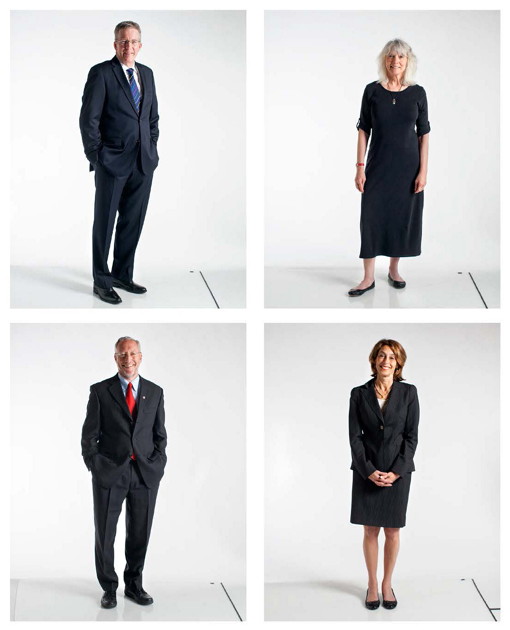
Q&A with Cornell's deans: On intellectual property, faculty renewal and the future of health care
In this, Ezra's third installment in an ongoing series of conversations with the academic deans of Cornell's colleges and schools, we delve into medicine and biomedical research at Weill Cornell Medical College and the College of Veterinary Medicine; rapid change at the School of Hotel Administration; and technological advances supporting high-level research at Cornell University Library.
How does a relatively small hotel school have such a big impact on the global hospitality industry? What are the benefits and risks of a medical college's partnerships with private industry? How is the role of university librarian today different than it was a generation ago? What's the single biggest threat to animal health?
Here are some thoughtful and surprising answers, from the men and women at Cornell's helm.
Anne Kenney
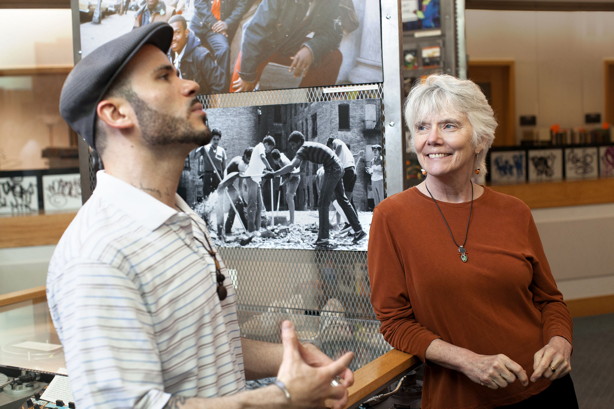
University Librarian Anne Kenney, right, chats with Ben Ortiz, assistant curator of the Hip Hop Collection, in Kroch Library.
As head of a major academic entity at Cornell, you're part of the academic deans' group, but "dean" isn't in your title. Should it be?
We're part of the Association of Research Libraries, a group of the 125 or so leading research and university libraries in North America, and roughly 40 percent of their librarians have "dean" in their titles, 10-12 percent have "vice president" or "vice provost" and the remainder have "university librarian" or some version of that. At Cornell it has always been "university librarian," and I think there is some tradition to having that stay. I do feel that I am squarely on the academic side of the university, not the administrative, and as one of the senior academic leaders, it seems appropriate to sit with the deans. While the library doesn't have faculty and students per se, we serve all of the faculty and all of the students. And our mission is to support their academic success, to stimulate their intellectual curiosity and to produce new knowledge.
What's the biggest obstacle to the library's success right now?
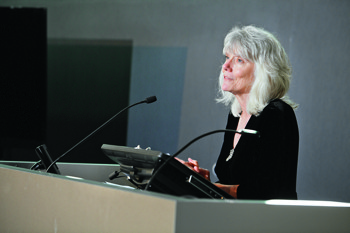
Kenney addresses a Reunion crowd at Milstein Hall in June 2012, introducing Jay Walker '77. See larger image
Like many other libraries and other parts of the university, we have been affected by the economic downturn. My major challenge at this point is to rebuild strong support for building collections. We have had flat collections budgets over the last four to five years, while the cost of securing material has risen above inflation, particularly with electronic resources. Faculty have expressed concerns about our ability to support Ph.D.-level research. Recently, fully a third of the faculty signed a petition to support building the collections. The Campaign for Collections, which is a $15 million effort, will be co-chaired by Jay and Eileen Walker. It will help Cornell remain competitive among the very best research libraries in the world. We will be kicking that off in the fall.
You have been a leader in developing standards for digitization of library materials and have seen huge changes in how students and faculty use libraries.
The pace of technological change has been doubling every couple of years, and I don't see that cycle slowing any time soon. It affects everything we do. The library is not an information technology organization; it's an information organization – but so much of that information is affected by technology. I think we will see within the next decade the dramatic shift of most content being online. Ebooks are set to outpace the production of all print, particularly in the area of scholarship; journals have almost totally gone electronic.
All of that online content will be challenged by intellectual property issues and what rights convey in the use of digital materials. Much of that is being played out in court cases right now. I am a strong believer that rights for libraries to provide information for educational and scholarly purposes must be protected in the digital domain, as they have been in the physical world.
What role does the library play in faculty recruitment?
Collections, and access to collections, is really key. And as new faculty come in, we are working to show them the kinds of materials that we have available for their research and teaching. For example, the development of a Ph.D. program for Africana studies has meant that I have spent more time trying to build special collections that will be supportive of that level of research. So there are the hip-hop collections that have come in, but we also just acquired the photographic morgue of the Amsterdam News, the oldest Harlem black newspaper, containing 300,000 images from the 1920s on. With new faculty, we also do orientations; we work extensively with faculty in the classroom, working on digital literacy and information competency.
What else is a crucial priority for the library's future?
If I had been named the university librarian in 1990 I would have known what to do: Just keep doing what had been done for a long time and not mess it up. Today, however, as we think about the needs of the academy and the role of a land-grant institution, how do we best serve Cornell? It is necessary for a great university to have a great library, as [first Cornell president] A.D. White said, but it's insufficient in the 21st century. So to serve Cornell, we need to think locally but act globally.
It is critical not to just build the very best library Cornell can have, but to make the library part of a broader network of information services and expertise. Our partnerships with Columbia University and universities in Asia come into that. Within the university, Senior Vice Provost for Research Bob Buhrman and I co-sponsor the research data management service group, and we have a partnership with the College of Arts and Sciences and Cornell University Press to support new forms of publishing scholarly monographs.
It's ironic that the library of the future will be both more virtual, in that we'll push out content and services, but also more personal, in that we will work directly with faculty and students to provide higher-level expertise, particularly at the edges of disciplines, where experts in one discipline become novices in other fields.
Who are you when you walk out the door of your office, or in the door at home?
I'm an avid hiker; I have summited Kilimanjaro and have been hiking in the Himalayas, in New Zealand and in Patagonia, and up and down the East Coast. Machu Picchu is next on my list. I garden, and I'm a very humble piano player; I'm very passionate about reading, and listening to, books.
The university librarianAnne R. Kenney, the Carl A. Kroch University Librarian At Cornell since 1987 University Librarian since April 2008 (interim from February 2007 to April 2008) Area of expertise: digital imaging, digital preservation, public services, users' information seeking behavior, collaborative models Cornell University LibraryPopulation: 120 academic and 276 nonacademic staff support the research, teaching and learning needs of 2,868 faculty and 22,400 students (figures include New York City and Geneva campuses) Areas of future emphasis: providing comprehensive access to the world's scholarship through building collections and collaboration; furthering digital information resource capacity; developing a dynamic virtual presence; developing services and resources for the Cornell NYC Tech campus; and fostering an innovative and collaborative staff culture Endowment: $96.5 million (as of April 2013) Cornell Now campaign goal/amount raised so far: $25 million / $15.3 million (as of June 2013) |
Michael Kotlikoff

Dean Michael Kotlikoff in his lab with research associates Bo Shui, left, and Frank Lee, center.
What are you most proud of so far?
We've started a number of exciting projects at the college. We have a very exciting capital project to adaptively reuse much of our 1957 space. We've started a large new referral hospital, Cornell University Veterinary Specialists (CUVS), in Stamford, Conn. We are working with City University in Hong Kong to create the first AVMA-accredited college in Asia. But, I think the thing that I'm most proud about so far in my deanship is the development of an outstanding leadership team in the college that includes outstanding department chairs, faculty leaders, and associate and assistant deans, and is aimed at transparency and developing collegewide consensus among faculty in making what are often difficult choices. I think that we've really come a long way in establishing a strong leadership core that will last at the college for a long time after I'm gone.
What is the main reason you opened CUVS?
It serves a number of functions for the college, long term. First of all, it does diversify our revenue in a way in which we don't rely in the long term on the state so exclusively. We're the one [statutory] college in Cornell that's not an undergraduate school, and we rely on the state more than any other college because the percentage of our revenue that comes from tuition is much, much lower than the other schools.
Plus, there's the fact that we're seeing changes in the profession that really call for some engagement of academic institutions in clinical practice. … Many specialty referral hospitals have grown up in the New York metro area that are terrific hospitals. They are highly efficient, but they don't participate in teaching and aren't doing the discovery that is important to keep the profession healthy. So we wanted to balance that and went to an area where there were not a lot of referral options, and we created something that is a kind of hybrid academic private-practice unit, which is financially very nimble and very strong. We are projecting about $9 million in total revenue from CUVS this year, which I think is fantastic for a start-up in its third year of operation, since the practice only succeeds if the referring veterinarians in the area view it as valuable. Finally, this practice is very important for philanthropy, as the college depends enormously on the support of grateful clients.
What is something that most people outside don't know about the college?
Probably the breadth. It's unique on the Ithaca campus in that we run three major units that interface directly with the public: our teaching hospital for animals, our diagnostic lab and our Stamford clinic. Together these represent in aggregate more than $40 million in revenue that is associated with direct interactions with clients. This is something that is quite different from the other schools on campus. And, we have an enormous research infrastructure annually attracting about $30 million in federal grants.
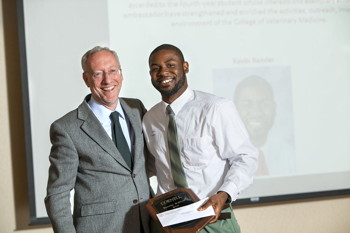
Kotlikoff with recent graduate Kevin Render '13. See larger image
What's the biggest problem in animal health today?
The lack of research funding that's available for investigating spontaneous diseases in animals. Over my scientific lifetime, [National Institutes of Health] funding has progressively centered more and more around human clinical research, and this is a very narrow-minded approach to understanding medicine and the biological basis of disease.
Many diseases – more than 60 percent of the infectious diseases that humans get – arise in animals; their natural hosts are animals; they should be studied in their natural hosts. As global population increases, we have more and more stress on environments, on wild animal populations, on food animal production. All of those areas have enormous impact on human health – they're just not quite as proximate an effect as the funding agencies are set up to deal with.
I've always felt that animal health, human health, environmental health really are different views of the same problem.
What avenues of inquiry are big now at your college or ripe for further investment?
The use of the dog as a genetic model for complex genetic diseases. Our human genomes are very similar – we probably have tens of thousands of differences between each of us humans, and so it's very difficult to isolate the thousands of differences in those genes that are linked to specific disorders. That's really where the dog comes in. Because dogs have a very similar genetic makeup, we can link those genes in a way that's much clearer, because the rest of the genome is so much more similar. Some very thoughtful and farsighted faculty more than a decade ago at Cornell developed a canine DNA and bio bank that banks material and DNA for specific diseases. So, you can imagine a dog with, for example, hip dysplasia and dogs that don't get hip dysplasia from the same breed, you can start to understand the specific genetic variations that really result in that hip dysplasia. Not only does that allow you to influence the health and well-being of dog populations, it also informs osteoarthritis in people.
A major opportunity here is with cancer. If a Great Dane lives long enough it will get osteosarcoma, a devastating disease that we see in rapidly growing bones of kids. This is a complex genetic vulnerability related to the size of the dog's long bones, which we are poised to be able to understand. This is one of those areas that provides a real impact on the health of animals, but also has an outstanding impact on gene discovery in people.
What's the most surprising thing you've heard lately from a student?
My wife, Carolyn, and I recently went to a dance consortium that is organized by students who are dancers, which was just superb. The time that they take outside of the classroom, the energy and commitment to produce something like that, within our own space (it was in the James Law Auditorium) is really phenomenal. And it isn't just dance. We have a choral group. We have a drama group. We have students doing musicals. Virtually every evening as you walk through the hallways here, you'll see some students rehearsing, singing, playing the piano, dancing, and that part is really surprising to me. It didn't exist when I was in veterinary school. It's something that's really a component of this college that is precious.
The deanMichael Kotlikoff, the Austin O. Hooey Dean of Veterinary Medicine At Cornell since 2000 Dean since 2007 Area of expertise: Processes underlying cardiovascular development, function and dysfunction; study of regenerative capacity of the heart The College of Veterinary MedicinePopulation: 210 faculty members, 360 professional students, 120 graduate students Areas of future growth: infectious disease research, genomics, medical genetics, stem cell biology, cancer research, expanded clinical networks, and international collaborations in animal health, public health and food safety Endowment: $186 million (as of June 2013) Cornell Now campaign goal: $75 million; raised so far: $36.1 million (as of July 2013) |
Laurie Glimcher
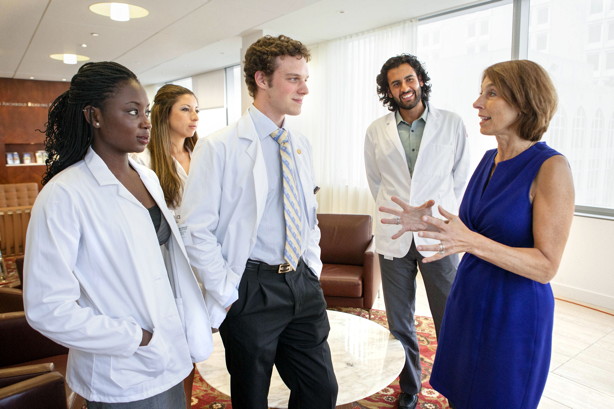
Dr. Laurie H. Glimcher, dean of Weill Cornell Medical College, right, chats with first-year medical students about what inspired them to become doctors. Photo: René Perez.
What are you most proud of in your first year and a half as Weill Cornell Medical College's dean and Cornell's provost for medical affairs?
I'm delighted to have recruited Lewis Cantley, Ph.D. '75, to head our new cancer center. He's one of the greatest cancer researchers in the world; earlier this year he won the Breakthrough Prize in Life Sciences. One of the reasons he came here from Harvard was because of the culture and the knowledge that we work as a team – surgeons, oncologists, pathologists and scientists all work together in translational research and medicine. I'm also happy to have established an office for faculty development and diversity, and spearheaded establishment of a child care facility. Finally, I like to think that I have established a transparent, open relationship with our wonderful faculty.
How do you balance these two roles?
I really consider that we're one university, one Cornell, and so I take my position as the university's provost for medical affairs very seriously. I established a good working relationship with the provost at Cornell, Kent Fuchs; I attend all board of trustees meetings and have very much enjoyed getting to know the trustees of Cornell University.
I think that David Skorton is an absolutely outstanding president – I am confident that he will go down in history as one of the greatest presidents of an American university.
What excites you about Cornell NYC Tech and its relationship with Weill Cornell?
The first recruit to that campus, Deborah Estrin, has a joint appointment at Weill Cornell Medical College and is actively collaborating with members of our Department of Public Health and other faculty. Her work on using smartphone technology to improve delivery of health care is stunning. I think there are going to be lots of productive interactions between our faculty and faculty on the Cornell NYC Tech campus.

Glimcher at GHESKIO in Port-au-Prince, Haiti, the site of one of Weill Cornell's key global health programs. Credit: Weill Cornell Medical College. See larger image
What is Weill Cornell's role in the rapidly changing health care industry? How are those changes affecting students, researchers and clinicians?
We want to be a voice in talking about – and even more important, helping to solve – the enormous problems of health care reform, health care policy, health care delivery and health care costs. One of my goals is to strengthen and expand our presence in that arena.
I encourage entrepreneurship and believe that the most efficient and effective way of translating our discoveries from the bench to the bedside can occur in partnership with the private sector. And so I have hired a director of our new office of industry-sponsored research alliances; we're already well on the way to establishing such alliances. Such partnerships are critical for the benefit of our patients more than anything else. And they also obviously allow us to continue our research at a time of pronounced fiscal restraints in funding by the federal and state governments.
What are the greatest potential rewards -- and risks -- of these industry partnerships?
The rewards: Actually delivering new therapeutics for patients, because that can be most effectively done by those partnerships. The risks, clearly, are conflict of interest and transparency. I like to use the quote (can't remember who it is from though) that sunlight is the best disinfectant. We need to be rigorous and thorough in disclosing any potential conflicts of interest. And we cannot compromise academic freedom – our freedom to publish our research.
Tell me about precision medicine and what we can do with it today.
The lowest-hanging fruit is in the application of precision medicine to cancer. That's where progress has already been made and the proof of principle obtained. We already have drugs that are targeted therapeutics, drugs like Gleevec [leukemia] and Xalkori [lung cancer]. A lot more can be done. Big data has to be collected on patients' tumors and used to mine the field for already available drugs, and then create new drugs based on each individual's unique genetic profile and the mutations that drive each patient's tumor. After cancer … it's limitless. … Ultimately, I see precision medicine as not only being used to treat patients, but even more importantly, being used to prevent disease.
What do you predict will be the most profound difference at Weill Cornell 10 or 20 years from now?
We don't know what the future research environment is going to look like. I'm an optimist, but we can't continue along this path of reducing government research funding because we will fall far behind other countries, including China. We will no longer be the country that produces the most innovative, transformative discoveries in biomedical research, discoveries that lead to cures for human diseases.
We are in the midst of a major revision to our medical school curriculum, and I'm spearheading that myself. There are going to be fairly substantial changes in the way we teach and engage our students and how we equip them to deal with a very rapidly changing health care world. We want our students to be the leaders of the next generation. … We had over 7,000 applications this year for only 100 slots, so we really get a wonderful crop of students with lots of diversity – 20 percent of our class is underrepresented minorities.
The deanLaurie Glimcher, M.D., Cornell's provost for medical affairs and the Stephen and Suzanne Weiss Dean of Weill Cornell Medical College, New York City At Weill Cornell since January 2012 Provost/dean since January 2012 Areas of expertise: Immunology, rheumatology, translational medicine, partnerships with the private sector, management oversight, corporate governance and finance Weill Cornell Medical CollegePopulation: 5,522 faculty members, 1,028 medical and graduate students (as of Oct. 1, 2012) Major areas of future emphasis: Translational bench-to-bedside research to benefit patients; treatments and therapies for some of the most formidable health challenges, including cancer, metabolic disease and neurodegenerative diseases; precision medicine and molecular imaging; and recruiting the best and brightest physicians and scientists to help lead Weill Cornell's research, educational and clinical missions. Endowment: $1.1 billion (includes $980 million endowment and $117 million in outside endowments/funds held by others, as of June 2013) Cornell Now campaign goals: Weill Cornell reached its $1.3 billion "Discoveries that Make a Difference" campaign goal in April 2013; its campaign is part of Cornell University's comprehensive capital campaign. |
Michael Johnson
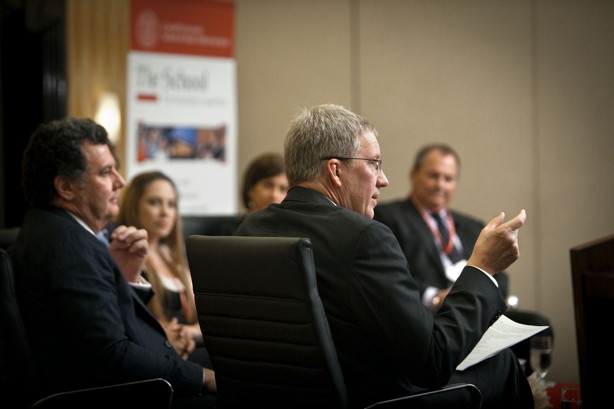
Dean Michael Johnson at a board meeting of the School of Hotel Administration's Center for Hospitality Research.
What is one thing people outside of your school don't know about the School of Hotel Administration?
That we're the best-grounded business program on the planet. I say that in all seriousness. We're different.
I tell the students: "We want about 70-75 percent of you to go into hospitality. If it's any less than that, then we've lost our grounding and lost what makes us unique; if it's more than that, we haven't given you a general enough education that you can take into any industry in any part of the world." I want them to go both into the hospitality industry and beyond, from Mumbai to Dubai, from Google to Wall Street. They should be able to go anywhere with this degree, and they do.
General management schools don't necessarily give students a grounded education. What I mean by that is, students learn every aspect of business from a particular dynamic context, which is hospitality. So whether you're learning HR management strategy, marketing, finance, accounting or operations, it's all grounded in the hospitality industry.
There are great management programs out there that will teach you how to work for someone else, how to have great team skills, communication skills, critical thinking skills, but they don't literally teach you how to run a business. Our students learn how to run a business. That's what makes them excellent entrepreneurs.
What accomplishment are you most proud of, in your time as dean?
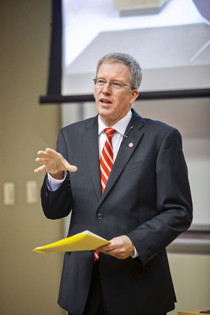
Johnson speaks at the dedication of the new Marriott Student Learning Center in October 2012. See larger image
I think to be an excellent dean, you have to do three primary things: You have to continue to create educational and vocational experiences for your students; you have to continue to hire an excellent faculty; and you have to fund the future.
On the student side, we have systematically found areas where they have an interest, whether it's in entrepreneurship or sustainability. Increasingly, we're looking at interdisciplinary topics such as labor relations in hospitality, which we're developing with the ILR School and the Law School.
One thing we try to accomplish very systematically is to grow the base of educational experiences and classes, and expand what that leads to in terms of job opportunities for students. We had the Center for Hospitality Research, and subsequently we developed the Pillsbury Institute for Hospitality Entrepreneurship. We then developed the Center for Real Estate and Finance, which coincided with the development of the undergraduate minor in real estate. We have about 350 students from every undergraduate school and college at Cornell in that program, so we provide that service to the whole university.
The second obligation was to renew the faculty … if there's one thing that a dean leaves behind, it's the faculty he or she has hired and developed. A dean may be here for 10 years, but faculty are here for 30 or more. The faculty I've hired is one of the things I'm most proud of, as they are the school's future.
And the third thing is to fund the future. We've raised $100 million over the last seven years for our students, faculty, programs and facilities. And there isn't a hospitality school anywhere in the world that's raised that kind of money to support its students, faculty and facilities.
What is your school's biggest barrier to success?
Our size. Hospitality is a huge industry. So it's clearly a challenge for us to continue to have the impact that we've had as a small school in upstate New York serving a global industry. At the same time, it's helped us stay focused on developing leaders for the industry.
Is there any danger of SHA falling from its position of the number one hospitality school?
Actually, we have increased the distance between ourselves and other hospitality programs in recent years. We have the highest-caliber students. We have a categorically higher-caliber faculty. We hire our faculty from top general management programs because they have an interest in applying what they do to our industry, so it's a great place for them to do their research and teaching. Our facilities are second to none. For hospitality, there is no place like Cornell.
Do you have a favorite moment from your seven years running the Dean's Distinguished Lecture Series?
I think my favorite moment is when J.W. "Bill" Marriott Jr. came a couple of years ago to give a lecture. Bill was probably 78 or 79 at the time. He is sharp as a tack. He's still very involved in the day-to-day operations of Marriott. This guy is so iconic to our students. When he came back to give the talk, you would have thought there was a rock star in the house. I believe even he was blown away by the attention he received from the students. And then, at the end of his talk, we announced the Marriott Foundation's $3 million gift, which was the foundation funding for the Marriott Student Learning Center. The applause was unbelievable. He got a standing ovation. That was one of my favorite moments.
What's the most interesting thing you've heard from a colleague or student lately?
One of our graduating seniors this [past] year, Rebecca Stuart, came to me last summer between her junior and senior years. She did an internship for US Airways, doing financial modeling for their HR department. She was modeling the long-term consequences of certain HR policies. Whereas the airline industry 15-20 years ago may not have been the best place to pursue a career, there are airlines today – Delta and US Airways among them – that are very well run, are profitable and are good places for students to work. She said, "I used absolutely every course I've taken at this school in that job." It was a nice reinforcement that the education we deliver is incredibly useful; it's incredibly practical; it prepares students very well for a wide range of pursuits.
The deanMichael Johnson, dean of the School of Hotel Administration and E.M. Statler Professor At Cornell, and dean, since 2006 Research expertise area: Services marketing; quality management; customer satisfaction and loyalty management; and consumer psychology. The School of Hotel AdministrationPopulation: 62 full-time faculty members, 908 undergraduates, 104 graduate students Areas of growth: global hospitality, entrepreneurship, labor relations, sustainability, medical care facility hospitality. Endowment: $131 million (as of July 2013) Cornell Now campaign goal and amount raised so far: $55 million/$41.6 million (as of July 2013) |